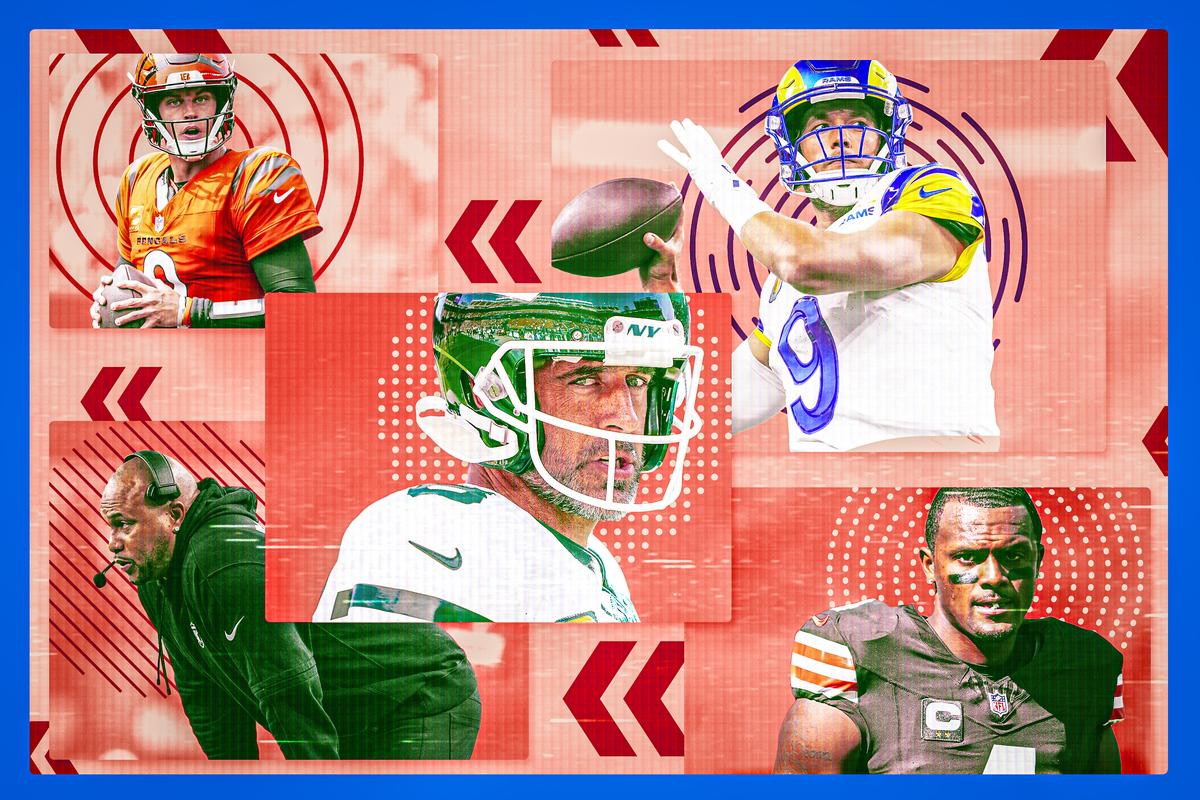
Welcome to NFL Under Review, a new weekly column where I will sound off on misguided narratives, inexplicable coaching decisions, and other topics around the NFL. Each Tuesday throughout the course of the season, you’ll get takes from me based on what happened the previous weekend, with an eye on what’s to come.
The Bengals offense will be fine.
There’s no getting around the fact that Cincinnati laid an egg in Week 1. The Bengals were the week’s biggest favorites, and they did not look ready to play, producing just 13 first downs, 224 yards, and one touchdown in a loss to the Patriots. It was an uninspired performance that has brought on all sorts of takes:
Joe Burrow is overrated.
You can’t win by playing offense this way.
They miss former offensive coordinator Brian Callahan.
My take? Relax. It was a bad game, but there’s no need to panic. The Patriots implemented a smart plan that we see often from big underdogs: shorten the game. The Bengals had just eight offensive possessions—the fewest in the NFL in Week 1 and three fewer than the league average. Cincinnati’s defense struggled to stop the Patriots’ run game, so Burrow’s unit didn’t get a lot of opportunities. When you have fewer chances, the mistakes are magnified, and it’s harder to make up for them.
The Bengals put together a 13-play, 63-yard drive that took 6:33 off the clock in the second quarter, but it resulted in no points. Burrow’s pass to tight end Mike Gesicki was initially ruled a touchdown, but a replay showed that the ball hit the ground. On the very next play, Burrow found tight end Tanner Hudson in stride, and Hudson was headed for the end zone before Patriots safety Kyle Dugger punched the ball out at the 1-yard line. It was one of four fumbles in this game, and the Patriots recovered three of them.
The Bengals ranked 10th among all teams in offensive success rate in Week 1. This metric is helpful because it measures whether each play had a positive result. For example, a 6-yard gain on third-and-5 is a positive. A 6-yard gain on third-and-10 is not. Using success rate tells us that on a down-to-down basis, the Bengals were producing results that were above league average in Week 1. The problem was they didn’t have a lot of opportunities, and they were a disaster on the high-leverage plays.
I’m not telling you the Bengals offense is perfect. Its best receiver, Ja’Marr Chase, played but is obviously unhappy with his contract, and his performance (six catches for 62 yards) wasn’t up to his typical standards. No. 2 receiver Tee Higgins was out with a hamstring injury. The scheme could definitely do more to give Burrow advantages, while Burrow can’t be content taking what the defense gives him. He needs to find ways to push the ball downfield. The Bengals had just one play of 20-plus yards in this game. It’s hard to win that way.
But we have a proof of concept to show that this thing can work. In 2022, when Burrow was healthy and teams were focused on limiting the Bengals’ explosive plays, the offense adjusted and finished fourth in efficiency. They have shown in the past that they can win by playing different styles of offense. As for Burrow, from a physical standpoint, he looked good in Week 1. He was scrambling and throwing on the move and delivering accurate passes.
The Bengals have some stuff to figure out, and it gets no easier with a matchup at Kansas City in Week 2, but as long as Burrow is healthy and Chase is on the field, the most likely outcome is that this offense will find a formula that works and have better performances going forward.
There is no longer an argument for Deshaun Watson’s on-field upside.
Everything about the Browns’ offensive performance against the Cowboys signaled: “PANIC!!!” Watson went 24-for-45 for 169 passing yards, with one touchdown, two interceptions, and six sacks. His dropback success rate was 23.2 percent—the lowest of any Week 1 starter. Watson was pressured 25 times—the most of any Week 1 starter. When he was pressured, he made bad situations worse, going 5-for-17 for just 22 yards and six sacks. I guess $230 million doesn’t go as far as it used to?
Yes, Watson was playing in less-than-ideal circumstances behind two backup offensive tackles. But to quote Don Draper, that’s what the money’s for. Watson is being paid to give his team a chance under those circumstances and to make up for shortcomings on the roster. But Watson has shown no ability to do that. In fact, he’s shown no ability to play at a high level even when the circumstances have been perfect. Among 41 quarterbacks with at least 400 dropbacks over the past three seasons, Watson ranks 39th in expected points added per pass play—ahead of only Zach Wilson and Bryce Young.
But the on-field data gets even worse. Over the past three seasons, Watson has started 13 games. His best game (as measured by dropback success rate) ranks in roughly the 62nd percentile for all quarterbacks. In other words, it’s not that Watson has been up and down or inconsistent. He’s been flat-out bad, and he’s shown no signs that he’s capable of producing a great game performance. The best version of Watson we’ve seen in a Browns uniform is one that offers only slightly above-average starting quarterback play. Forget about the quarterback we saw with the Texans in 2020. Unless we are provided with new on-field evidence to the contrary, we can safely assume that football player no longer exists.
And none of this criticism of Watson and his play accounts for the very serious concerns about his off-field behavior and his treatment of women. On Monday, ProFootballTalk reported that a woman has filed a lawsuit in which she says Watson sexually assaulted her during a date in 2020. The details in the new lawsuit are heinous and strikingly similar to the abuse two dozen women who previously filed lawsuits against Watson said they experienced after they were hired by the then-Texans quarterback to give massages. Two Texas grand juries declined to indict Watson on criminal charges related to the previous lawsuits, and he settled most of them, but the NFL determined he violated the league’s personal conduct policy, and he served an 11-game suspension in 2022.
For now, the Browns will continue to move forward with Watson as their starting quarterback. They still have a chance to be a competitive team this season because their defense is legit, and Kevin Stefanski is a good head coach. But we’re now in year three of the Watson era, and it’s clear that Cleveland has a quarterback problem that it doesn’t know how to solve.
The 49ers offense still looks like the 49ers offense.
So much about this 49ers offseason has screamed that a Super Bowl hangover is underway. The Brandon Aiyuk trade request. The Trent Williams holdout. Christian McCaffrey’s calf injury. Minutes after the 49ers lost to the Chiefs in February, their players and coaches talked about how the most devastating thing was knowing what it would take to get back there. There’s a reason only one Super Bowl loser this century has returned to the final game the next season.
But aside from the fact that McCaffrey was (surprisingly) inactive on Monday night against the Jets, the 2024 version of the 49ers looked pretty much exactly the same as the 2023 version did. It was like nothing had happened this summer, and they were just picking up where they left off. They had a three-and-out and punted on their first drive. But after that, they scored on their next eight possessions and piled up 401 yards in a blowout 32-19 victory over the Jets. Quarterback Brock Purdy was an efficient distributor. Deebo Samuel motored past (and through) defenders. Backup running back Jordan Mason ran for 147 yards. And head coach Kyle Shanahan made it look easy, putting Jets defenders in a blender down after down and possession after possession.
It’s unclear how much time McCaffrey will miss, and at some point, that will matter. But with the continuity and talent the 49ers have on offense, they have the luxury of not needing to rush McCaffrey back. They can let him get healthy with the big picture in mind and still light opponents up on a weekly basis. It’s one game in a long season, but after a tumultuous summer, the familiar feelings on Monday night had to feel good for the Niners.
The Jets offense has plenty to figure out.
Let me prove that I am not a Jets hater and start with the positive. Aaron Rodgers did some Aaron Rodgers things on Monday night. His arm looked as live as ever. He made some big-time throws to Garrett Wilson and Allen Lazard. He drew the 49ers offside, took the free play, and found Lazard for a touchdown. From a physical standpoint, this was not a situation where you thought, “Oh no! He looks like a 40-year-old coming off of an Achilles injury!” And given how Kirk Cousins played on Sunday, that’s a pretty big deal (sorry, Kirk).
Now, for everything else. On one sideline, we had Shanahan dialing up explosive plays for fullback Kyle Juszczyk. On Rodgers’s sideline, we had camera shots of offensive coordinator Nathaniel Hackett staring at a tablet. Be honest. You forgot that Hackett was the Jets’ offensive coordinator, didn’t you? Yeah, I kind of did too. There was that whole story line about how the Jets tried (but failed) to replace him this offseason, and now September is here, and the guy is still hanging around and calling plays. On one hand, Rodgers has control at the line of scrimmage, and the offense will run the way he wants it to run. On the other hand, Rodgers has plenty on his plate with all the usual quarterback stuff. Someone has to design the offense and the game plan and call the plays. And that person is apparently still Hackett.
The Jets’ game plan was to run the ball early and often. Through the first three quarters, when the game was still relatively competitive, they ran it 13 times for 31 yards (2.4 yards per carry) on early downs. They had the worst rushing success rate on early downs of any offense in the NFL in Week 1, yet they stuck with it and kept putting themselves in tough third-down situations. The Jets had nine possessions with Rodgers in the game, and they failed to pick up a first down on five of them. They failed to pick up more than one first down on seven of the nine possessions.
The offense still has a chance to be competent. If the line holds up (and it was OK in pass protection against the 49ers), Rodgers has some pieces to work with in Wilson and Breece Hall (and maybe his old Green Bay buddy Lazard?). But if the Jets are going to be truly successful, it’ll be almost entirely on Rodgers’s shoulders. The scheme and coaching aren’t giving him an edge. Monday night was an important reminder of that.
The Rams are now an “infrastructure” team.
Allow me to explain what I mean by this. There are certain teams in the NFL that deserve the benefit of the doubt because of the infrastructure, starting with the head coach–quarterback combination. The Chiefs are one example. As long as Patrick Mahomes is healthy and Andy Reid is the head coach, they’ll have a chance to be really successful, regardless of all the other factors. I would put the Ravens with John Harbaugh and Lamar Jackson in that category too. There’s a strong argument building for the Bills with Sean McDermott and Josh Allen as well.
Previously, I didn’t have the Rams in that category. When I was preparing for this season, I looked at things like their lack of talent on defense, the loss of Aaron Donald, and the injuries on the offensive line, and I wondered whether they’d be a good team this season. The Rams lost in overtime to the Lions on Sunday night, but as I was watching that game, I came to the realization that as long as they have Sean McVay and this version of Matthew Stafford, they’ll always have a chance.
The Rams went into Week 1 down both of their starting offensive tackles. During the game, they lost their second-string left tackle and their starting left guard. They also lost wide receiver Puka Nacua. Yet the Rams still piled up 26 first downs—tied for the most of any team in Week 1. They had the eighth-best success rate for any offense. One of the most valuable things in the NFL is having a coach and/or a quarterback who can problem solve. There will be injuries and bad matchups and unlucky bounces and unfortunate calls. The bad teams use those things as excuses. The good teams figure it out anyway.
That’s what we saw from the Rams on Sunday night. We saw it in how Stafford knew when to get rid of the ball and how to adjust his arm angles, take hits, and get back up. McVay was doing everything he could to scheme it up and call the right plays and put his players in positions to succeed. It wasn’t perfect, and the Rams still lost the game (Stafford didn’t get a chance to touch the ball in overtime), but the work McVay and Stafford did to give the Rams a chance on the road against a good Lions team is still really, really impressive.
I don’t know how this season will go for the Rams. It’s possible that the injuries will become too much to overcome. But as long as Stafford is on the field and McVay is on the sideline, I’m not counting them out in the NFC.
Antonio Pierce has the belt for the NFL’s worst in-game decision-maker.
Josh McDaniels, if you’re reading this, I send my apologies. Yes, you earned the honor last year, but you must still be employed as an NFL head coach to qualify in 2024. It’s time to relinquish the belt.
Which brings us to Pierce. The Raiders lost, 22-10, to the Chargers on Sunday. They lost for a number of reasons, including being minus-three on turnovers and totaling just 14 first downs on offense. But Pierce’s in-game decision-making certainly didn’t help. He made the kind of conservative choices that we rarely see from a coach in the modern NFL. These were straight out of a 1994 coaching handbook.
The first baffling decision came with 10:30 left in the game. The Raiders were trailing 16-7 and faced a fourth-and-1 from the Chargers’ 14-yard line. This is an obvious “go for it” situation. The Raiders had scored one touchdown all game and were now 14 yards away from the end zone. They would have to score a touchdown at some point to win the game. This is when you have to be aggressive. Even if you don’t get it, the Chargers would be pinned back. It’s 1 freakin’ yard! But Pierce instead chose to kick a 32-yard field goal.
Yet the next decision was even more mind-boggling. The Raiders had a fourth-and-1 at the Chargers’ 43 with 7:15 left. They were losing 16-10, knowing they needed a touchdown to win the game. And Pierce punted!
You CANNOT punt in that situation. I don’t want to hear about how the Raiders defense was playing well or about how it was a long yard or about how you have to coach with your gut. Punting in that situation is flat-out coaching malpractice. You can’t ask your players to give you everything they’ve got and tell them that you trust them and believe in them and then punt in that spot. Punting there is making a decision that goes 100 percent against the idea of giving your team the best chance to win. We might not see a more obvious “go” situation in which a team chooses to punt all season.
I’m really not trying to pick on Pierce. I fully understand that game management is just one small aspect of coaching. There is communication and leadership and scheming and a host of other things that Pierce is responsible for. There’s also a lot going on during the course of a game, and it’s easy for a coach to make a mistake when he needs to think and act quickly. That’s why so many coaches have someone in their headset they can trust to tell them what to do in those spots.
The big concern for me here is that Pierce was bad at this stuff last season as well. He was the most conservative coach in the NFL after taking over from the aforementioned McDaniels midway through the 2023 season. But I gave him the benefit of the doubt since he was an interim head coach learning on the fly and jumping into a new situation. The fact that no one in the organization addressed this with Pierce during the offseason is troubling.
The NFL is all about trying to gain small edges. Nine games in Week 1 were decided by seven points or fewer. You don’t need to be an analytics nerd. You just need to use the data to help you make smart decisions to give your team the best chance to win. Pierce didn’t do that on Sunday, and he hasn’t done that since he took over last season.


